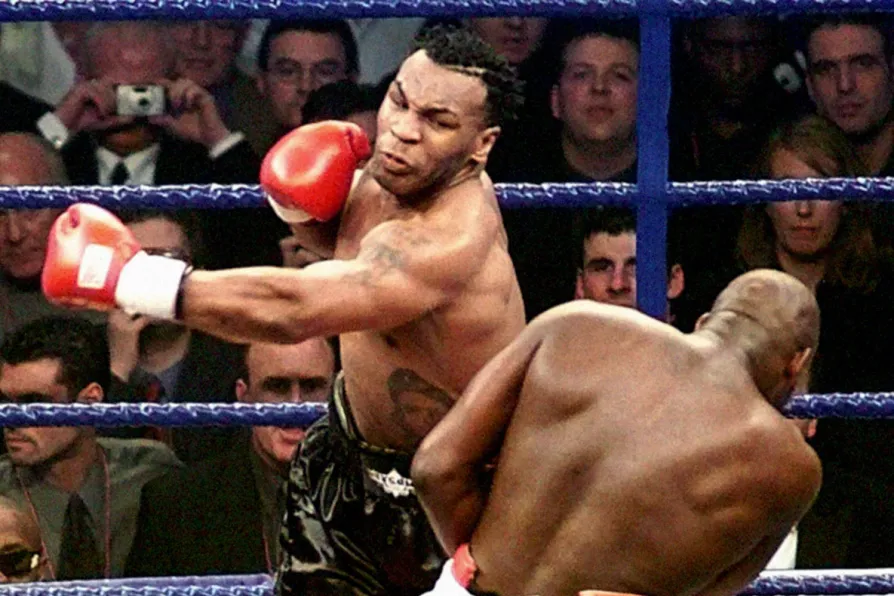JAMES NALTON on Munyua’s stinging success at the World Darts Championship
In recently published book Baddest Man, Mark Kriegel revisits the Faustian pact at the heart of Mike Tyson’s rise and the emotional fallout that followed, writes JOHN WIGHT

 Boxer Mike Tyson (left) throws a punch at Julius Francis, during their heavyweight fight at the Manchester Arena, January 29, 2000
Boxer Mike Tyson (left) throws a punch at Julius Francis, during their heavyweight fight at the Manchester Arena, January 29, 2000
STILL to this day the allure of Mike Tyson has not diminished in the collective mind of Western sporting culture. Only Muhammad Ali casts a larger shadow in this regard in the annals of heavyweight boxing history. And like Ali, Tyson remains one of the few boxers to have crossed over into the realm of public consciousness to the point where his name once evoked — and still does for many — the kind of emotional response consonant with a character from Greek mythology.
In the pages of his recently published book on the life and times of Mike Tyson, Baddest Man, author Mark Kriegel offers up a profound inquiry of his subject that takes the reader on a journey into the human condition that is worthy of Dostoevsky.
Tyson, in his time and prime, occupied the space in black heavyweight boxing folklore that had once been occupied by Sonny Liston, who himself had occupied it in the tradition of Jack Johnson. Said tradition is of “unapologetically black” and surly heavyweights within the American racial firmament, who with their propensity for violence in the squared circle have reminded white America of the danger that lurks in its midst in the form of potential retribution for a history of racial oppression.
The ring exploits of the aforementioned legends allowed put-upon black men from the ghetto to believe in the power of “badness” — in other words, in the positive role of violence when it comes to the reassertion of masculine strength and power as a response to racially defined structural alienation.
Brownsville, New York, is where Tyson grew up in the 1970s. It was place to be survived rather than lived in. As Kriegel describes: “In 1940, William O’Dwyer, the district attorney who became famous for prosecuting Murder Inc [New York organised crime], declared that Brownsville was responsible for ‘spawning more gangsters and criminals than any other section of the city’.”
Brownsville was then and remains now a place where Rosa Luxemburg’s famed formulation of “socialism or barbarism” is played out on the daily. In such places the dynamic of predator or prey is the stark choice facing young men, along with the monumental and life-changing consequences attached to either.
Tyson chose in his fraught early teenage years the role of predator. In so doing he gave birth to the life of violence that culminated in him being lauded in the name of commerce.
Incarceration took him off the streets at the age of 12, perhaps in the process saving his life, and from there the myth took its wings. It holds that his desire to seek salvation in a pair of boxing gloves began soon thereafter.
Kriegel: “Tyson had never boxed before, nor was he a boxing fan. He was, however, enthralled by Muhammad Ali. Like Ali, he wanted to be famous.” And famous he would rapidly become at the direction of boxing’s very own Yoda in the personage of Cus D’Amato.
D’Amato occupies a unique place in the history and legacy of boxing. His reputation is at once that of saint in the land of sinners, a lone thinker amid a crowd of the unthinking, and the pure of heart among the heartless. However the truth, as Oscar Wilde reminds, is rarely pure and never simple.
D’Amato was a martinet for whom life was an exercise in personal and self-abnegation in the cause of personal cleansing. Boxing for him was the arena in which men worked through their natural fears in the cause of the realisation of a higher purpose. The works of Nietzsche were his bible, and beyond Floyd Patterson and Jose Torres, Mike Tyson became his most important live experiment in same.
D’Amato: “What is the difference between a hero and a coward? No difference. Only what you do. They both feel the same. They both fear dying and getting hurt. The man who is cowardly refuses to face up to what he’s got to face. The hero is more disciplined and he fights those feelings off and he does what he has to do.”
Cus D’Amato found in the young and eager boxing mendicant, Mike Tyson, the soft wax upon whom he could impart his particular wisdom and beliefs. Out of the alchemy forged came the brutal rejoinder to the notion of boxing as the noble art.
Tyson’s objective in the ring was not merely the defeat but the wholesale destruction of his opponents. It informed an explosive front-foot style that fans of the sport signed up to to the point of turning Tyson into a boxing and cultural icon by the age of 21. They relished the muscular malevolence and his refusal to play the part of corporate poster boy. Within him, on the contrary, resided the spirit of the beast in human form. But then the human aspect could not and never be denied beyond a certain point, which is where his descent into the abyss of emotional turbulence began.
As Kriegel has it: “Whatever Tyson accomplished, he still wondered how it would play back home [in Brownsville]. That he no longer had a Brooklyn address didn’t mean he’d ever left. Or ever would.” In other words, even at the height of his fame, the ghetto never left him. His mind and spirit had been forged in the crime-ridden streets Brownsville, and informed his malevolence in the ring. It was his currency when it mattered, and also the monkey on his back that brought him close to self-destruction.
Today, Tyson is a purveyor of wisdom and a passionate advocate of cannabis. He espouses the life lessons of a man who made it to the top of the mountain, only to find it barren. In a recent Instagram post he stated the following: “I’ll be 60 next year and I’m not here to impress anyone. I’ve been the champion. I’ve been the villain. I’ve had gold around my waist and nothing in my soul. Now? I just want peace. Everything else is noise.”










